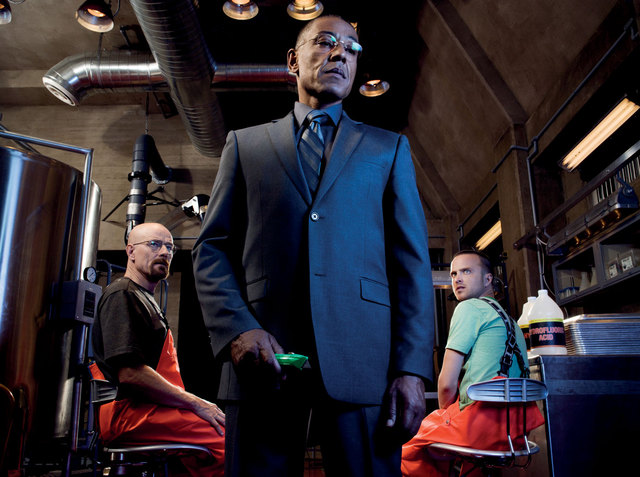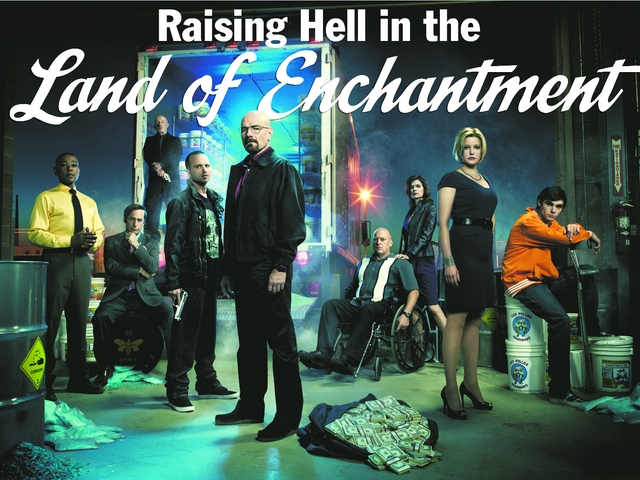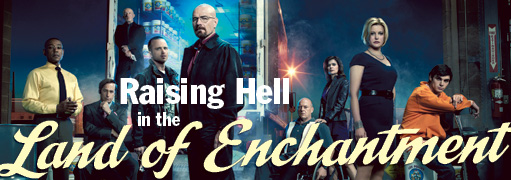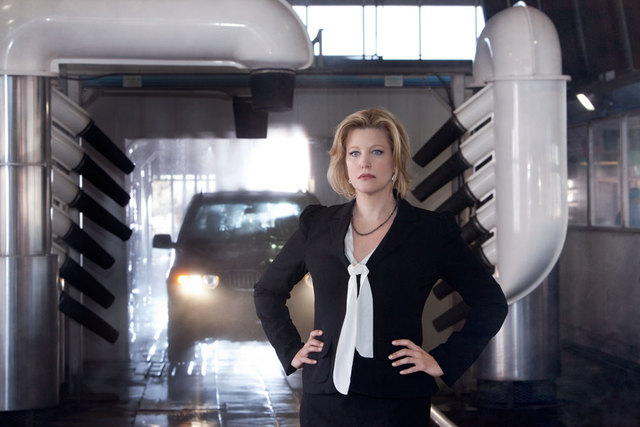No Place Like Home
Gilligan’s vision of the Duke City is reminiscent of something author Nelson Algren once wrote of his hometown Chicago: "Like loving a woman with a broken nose, you may well find lovelier lovelies. But never a lovely so real." In the same vein, Gilligan conjures a distinct feeling of Burque through methed-up hookers in front of the Crossroads Motel, saturated skies over the Sandias, paper bags dripping with Lotaburger grease and hardworking folks doing what it takes to get by. The mixture of beauty and ugliness serves as a fitting ode to Albuquerque. And that attention to location is also why Gilligan refers to the city as "a central character in the show.""We use the real streets. We shoot the heck out of Albuquerque," says Cranston. "We’re being honest and showing you, Here’s some good stuff, here’s some great places, here’s some, um, interesting places you might want to be careful around. I think that’s the whole mark of our show—to be honest."Just ask Steven Michael Quezada, who plays a DEA agent named Gomez. He grew up near Pat Hurley Park on Albuquerque’s Westside, and nowadays he volunteers at Youth Development, Inc. and leads acting classes at the Albuquerque performance center Triple Threat. "Where I grew up, everybody was joining gangs," he says. "So it was difficult. You had to fight your way to school, fight your way back from school." A few years before he began working on "Breaking Bad," he says he started to notice what a problem meth was causing in his hometown. "Unfortunately, it’s affected my family.”Still, Quezada says there’s no place he would rather work as an actor. His ability to do that, however, may be on the decline. The Land of Enchantment’s filmmaking boom, ushered in by former Gov. Bill Richardson’s film industry tax incentives, took a hit in this year’s legislative session. The 25 percent rebate on film project money was capped at $50 million a year. After one or two big-budget projects are shot, the reservoir could run dry, leaving no incentive—financially or otherwise—for anyone to shoot here for the rest of the year. And while “Breaking Bad" is the most definitive portrait of Albuquerque to hit the airwaves, if it weren’t for the rebate program, it would have never happened. At least not here. The show was originally scripted for Riverside, Calif., before Sony Television approached Gilligan about the financial upside to shooting in Albuquerque. "New Mexico was not a contender until this incentive program came along," Gilligan says. He says that most of the "Breaking Bad" crew are New Mexicans who might have trouble finding work in the film industry if it weren’t for the incentive. To that end, Quezada has gone to bat for filmmaking here. He took a camera crew to Santa Fe for the recent session. After interviewing state representatives and senators, he says he thinks the cuts are more about a political power struggle than the welfare of New Mexicans. "I think the Republicans don’t want the film industry here,” he says. “It brings powerful, rich Democrats to this state, and they don’t want that in this state. They want to have the power. They want to have the money. They want to have control." Dovetailing that, he says, Republican Gov. Susana Martinez wants to dismantle what could be Democrat Richardson’s most lasting legacy.While Gilligan says he sees a fifth season of his show in the cards—and probably no more than that—he’s not sure what would happen without incentive money. "It seems to me that it would make it hard for us to come back, to be honest. We are pretty close to the bone as it is."Ironically, Martinez’ camp called Quezada earlier this year to try and enlist him in their efforts. "They called me and they wanted me to join their campaign, and here they are totally destroying the industry,” he says. “And then they all tell me, She’s Hispanic, you should support her. And I’m like, I want to support people who support people."Breaking the Ice
Despite the storm clouds off set and in the script, a day on the set of "Breaking Bad" is an experiment in 13-hour work schedules and various states of comedic undress. It makes for a devilish chemistry among cast and crew. Anna Gunn, who spent her formative years growing up in Santa Fe, relates a bedroom scene she was filming with Cranston for the pilot. "He’d put a water bottle down his tighty-whities and he had some feather boa on as far as I remember, and he came and started humping me and attacking me." Cranston, who has directed episodes of "Breaking Bad," has also arrived on set in full Fritz Lang regalia—beret, monocle, riding whip and stern German accent included. But that sort of flair for the unexpected, Gunn says, "just speaks to Bryan’s boldness as an actor."Cranston is a natural humorist, and he sees it as necessary in creating a professional and relaxed atmosphere. "I’ve been in the business 32 years. I’ve been on sets that are tense, sets that are uncomfortable, sets that are just plain horrible,” he says. “And I just don’t want to have anything to do with that."Betsy Brandt, who plays the role of Skyler’s needling sister, Marie, praises Cranston for the working environment he creates. "The star usually heads the tone for the kind of temperament on the show, and he could not be nicer,” she says. “I can have a trucker mouth, and it’s embraced. If I worked at the office that wouldn’t go over so well. That kinda shit would not go over."With the average season taking half a year to shoot, some elements from the show crop up in the actors’ lives well after the cameras stop rolling. Aaron Paul, who won an Emmy for the role, has some scripted affectations that he can’t seem to drop. Said with a fiery bravado, they’re colorful appendages to the end of Jesse Pinkman’s sentences. "It’s funny,” he says. “Not really with ‘bitch,’ but ‘yo,’—it takes me awhile to get it out of my vocabulary. I tend to say ‘yo’ all the time.”Back to Black
"This season is definitely the most intense one yet,” Paul says. “It keeps getting darker and darker in such a great way."Like Paul, Giancarlo Esposito says he’s also dealt with character infestation. On screen and off, he’s the eloquent, calm element in the chaotic chemistry of "Breaking Bad." He came onto the show at the end of Season 2 as Gustavo Fring, a meth kingpin and fried-chicken-chain svengali who uses his calculating business wiles to "hide in plain sight." This season presented him with a scene that impacted him on such an intense personal level that he says he had to put down the script for three days and try to rationalize his character. The scene made him nervous, he says. "I wanted to be able to find a route out for Giancarlo, not for Gus. I wanted to be able to find a way back into my life without getting anything on me and having it scar me, my spirit." (An actor’s actor, Esposito says he draws parts of Gus’ polite, graceful demeanor from a past career of waiting tables.) The show’s rationalization of evil is a tool that keeps the characters grounded and morally ambiguous. "The show surprises me—believe it or not—with its darkness sometimes, because Walt takes the writers and myself to some pretty dark places,” says Gilligan. "That sounds kinda artsy-fartsy, but in a sense Walt takes us, the writers, on this journey. We try to be open to what interests him and what drives him and what motivates him and what he fears." From that, Gilligan says he finds ways to justify the evils of characters like Walt, Gus and Jesse—at least in their own minds. And it almost always leads back to the idea of protecting the family. Whether it’s borne from marriage or business is inconsequential.“That’s first and foremost I think what drives Skyler,” says Gunn, whose character keeps things together by clenching her teeth in the face of adversity. Gunn says Skyler is also beginning to delve deeper into her own form of breaking bad as Season 4 progresses. “I think the way Walt kind of got empowered by his Heisenberg persona, Skyler’s being empowered by this other aspect of her life where she actually gets to walk in and say, ‘OK, now, no—if we’re gonna do this, we’re gonna do it right and here’s what we’re gonna do’,” she says. “But it involves doing things morally she certainly has to struggle with.”Gus, on the other hand, has a steely resolve that makes it difficult to tell where his moral concerns lie, or if he has any to begin with. "I believe that Gus is a good human being who thinks in his mind that he really is doing good and helping people," Esposito says of his character. "It’ll be interesting for the audience when they start to realize the underpinnings of why this man is so controlled, so methodical, so precise, and yet so polite and graceful."As for Cranston’s character, Gilligan used to be concerned that the show would come to an end because Walt might become too unlikable to be a protagonist. "I confess, I used to think a lot about that,” Gilligan says. “And the longer this show goes the more I realize that Walt—at least to my writers and to myself—remains fascinating. In fact, the darker he gets the more exciting he becomes."Even more cast and creator insights on “Breaking Bad.”













